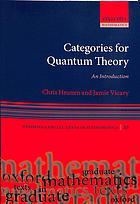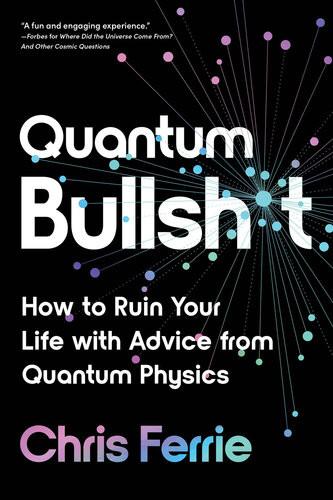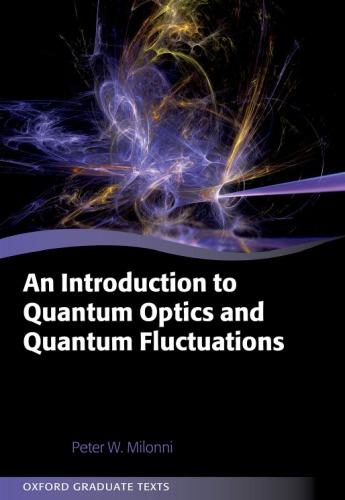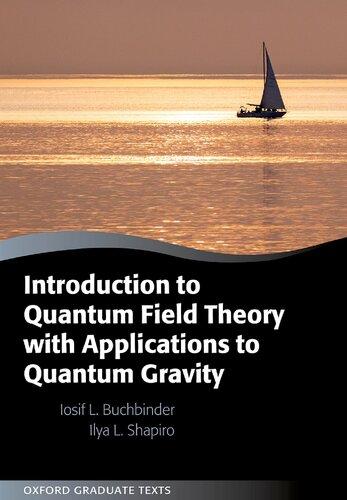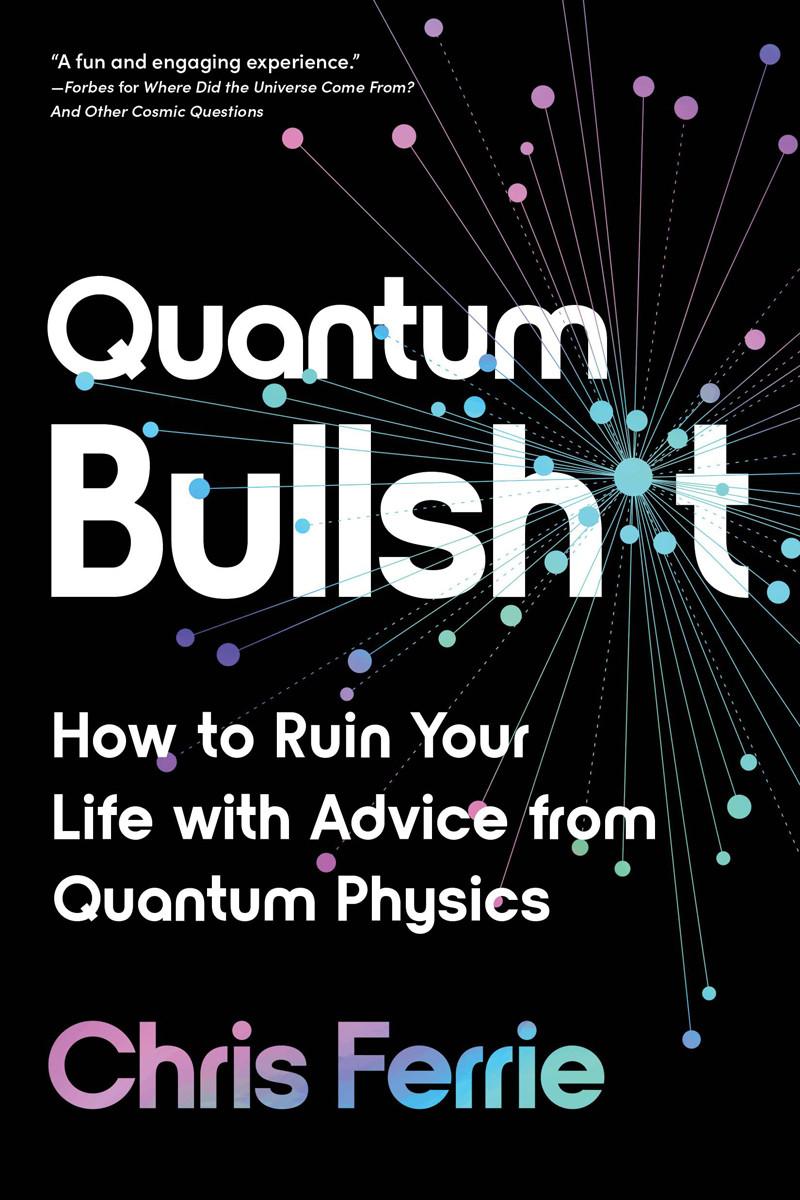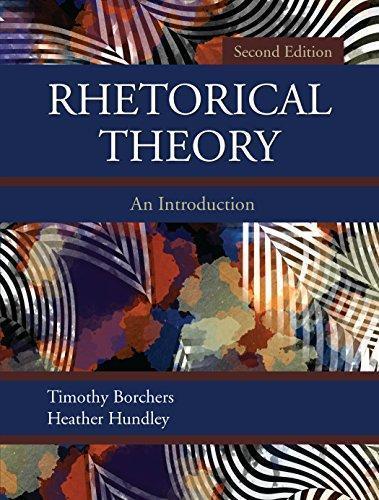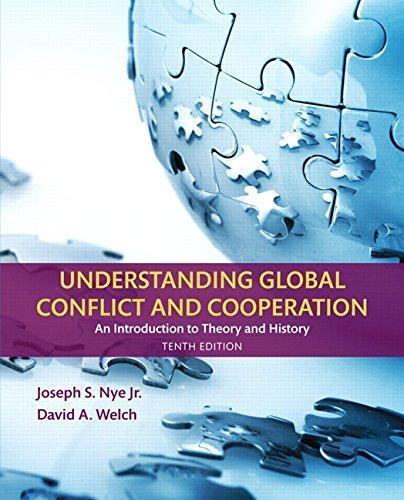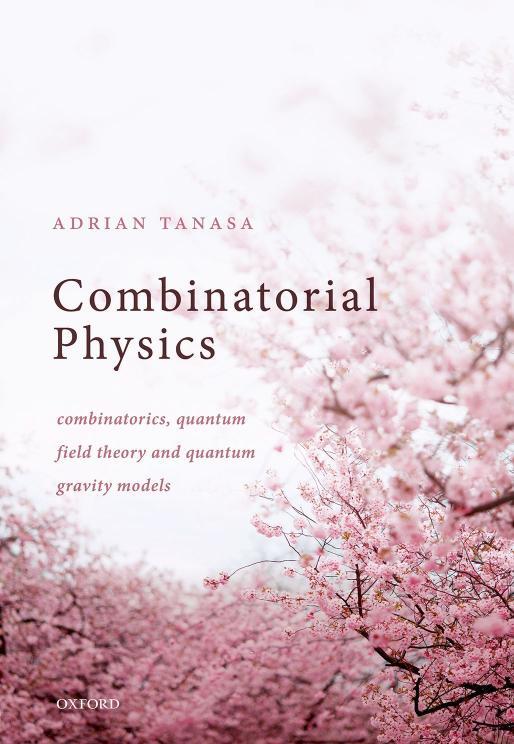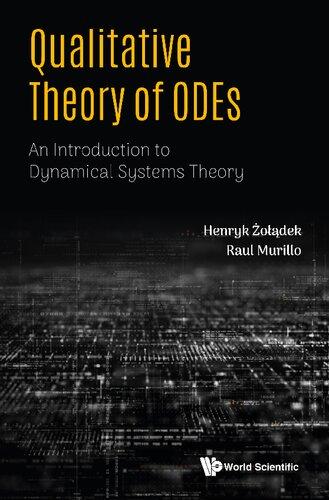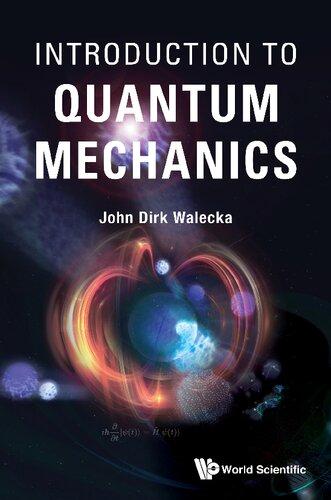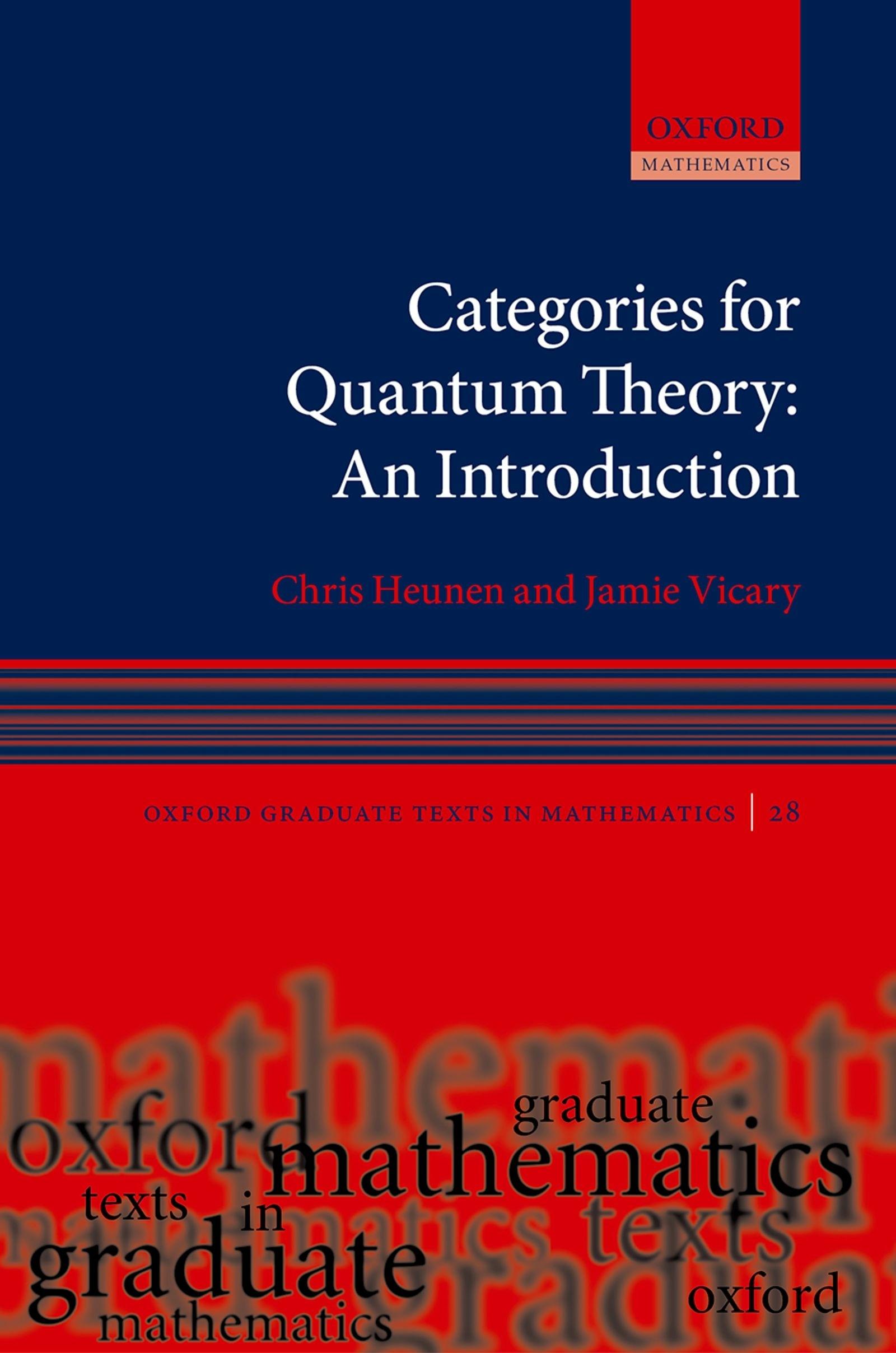Categoriesfor QuantumTheory
AnIntroduction
chrisheunenandjamievicary UniversityofEdinburghandUniversityofBirmingham
GreatClarendonStreet,Oxford,OX26DP, UnitedKingdom
OxfordUniversityPressisadepartmentoftheUniversityofOxford. ItfurtherstheUniversity’sobjectiveofexcellenceinresearch,scholarship, andeducationbypublishingworldwide.Oxfordisaregisteredtrademarkof OxfordUniversityPressintheUKandincertainothercountries
©ChrisHeunenandJamieVicary2019
Themoralrightsoftheauthorshavebeenasserted FirstEditionpublishedin2019
Impression:1
Allrightsreserved.Nopartofthispublicationmaybereproduced,storedin aretrievalsystem,ortransmitted,inanyformorbyanymeans,withoutthe priorpermissioninwritingofOxfordUniversityPress,orasexpresslypermitted bylaw,bylicenceorundertermsagreedwiththeappropriatereprographics rightsorganization.Enquiriesconcerningreproductionoutsidethescopeofthe aboveshouldbesenttotheRightsDepartment,OxfordUniversityPress,atthe addressabove
Youmustnotcirculatethisworkinanyotherform andyoumustimposethissameconditiononanyacquirer
PublishedintheUnitedStatesofAmericabyOxfordUniversityPress 198MadisonAvenue,NewYork,NY10016,UnitedStatesofAmerica
BritishLibraryCataloguinginPublicationData Dataavailable
LibraryofCongressControlNumber:2019941499
ISBN978–0–19–873962–3(hbk.)
ISBN978–0–19–873961–6(pbk.)
DOI:10.1093/oso/9780198739623.001.0001
Printedandboundby CPIGroup(UK)Ltd,Croydon,CR04YY
Preface
Theideaforthisbookcamefromamini-courseataspringschoolin2010,aimedat beginninggraduatestudentsfromvariousfields.Wefirstdevelopedthenotesin 2012,whentheyformedthebasisforagraduatecourseattheDepartmentofComputer ScienceinOxford,whichhasruneveryyearsince.Asof2016,aversionofthiscourse hasalsorunintheSchoolofInformaticsinEdinburgh.Thetextformedthebasisfor postgraduatesummerandwinterschoolsinDalhousie,PisaandPalmseaswell,andhas improvedwithfeedbackfromallthesestudents.
Inselectingthematerial,wehavestrivedtostrikeabalancebetweentheoryand application.Applicationsareinterspersedthroughoutthemaintextandexercises,but atthesametime,thetheoryaimsatmaximumreasonablegenerality.Theemphasisis slightlyonthetheory,becausetherearesomanyapplicationsthatwecanonlyhintat them.Proofsarewrittenoutinfull,exceptahandfulthatarebeyondthescopeofthis bookandacoupleofchoresthatareleftasexercises.Wehavetriedtoassignappropriate credit,includingreferences,inhistoricalnotesattheendofeachchapter.Ofcourse,the responsibilityformistakesremainsentirelyoursandwehopethatreaderswillpointthem outtous.Tomakethisbookasself-containedaspossible,thereisazerothchapterthat brieflydefinesallprerequisitesandfixesnotation.
ThistextwouldnotexistwereitnotforthemotivationofBobCoecke.Between inceptionandpublicationofthisbook,heandAleksKissingerwroteanotheronethat targetsadifferentaudiencebutcoverssimilarmaterial[44].Thanksarealsoduetothe studentswholetususethemasguineapigsfortestingoutthismaterial.Finally,we areenormouslygratefultoJohn-MarkAllen,PabloAndresMartinez,MiriamBackens, BruceBartlett,OscarCunningham,BrendanFong,PauEnriqueMoliner,TobiasFritz, PeterHines,MarttiKarvonen,AlexKavvos,AleksKissinger,BertLindenhovius,Daniel Marsden,AlexMerry,VaiaPatta,DavidReutter,FranciscoRios,PeterSelinger,SeanTull, DominicVerdon,LindeWesterandVladimirZamdzhievforcarefulreadinganduseful feedbackonearlyversions.
ChrisHeunenandJamieVicary EdinburghandBirmingham,December2018
Introduction
Physicalsystemscannotbestudiedinisolation.Afterall,wecanonlyobservetheir behaviourwithrespecttoothersystems,suchasameasurementdevice.Thecentral premiseofthisbookisthattheabilitytogroupindividualsystemsintocompound systemsshouldbetakenseriously.Weadopttheactionofgroupingsystemstogetherasa primitivenotionandinvestigatemodelsofquantumtheoryfromthere.
Thejudiciouslanguageforthisstoryisthatofcategories.Categorytheoryteaches thatalotcanbelearnedaboutagiventypeofmathematicalspeciesbystudyinghow specimensofthespeciesinteractwitheachother,anditprovidesapotentinstrument todiscoverpatternsintheseinteractions.Noknowledgeofspecimens’insidesisneeded; infact,thisoftenonlyleadstotunnelvision.
Themethodsofcategoriesmightlooknothinglikewhatyouwouldexpectfroma treatiseonquantumtheory.Butacrucialthemeofquantumtheorynaturallyfitswith ourguidingprincipleofcompositionality:entanglementsaysthatcompleteknowledge ofthepartsisnotenoughtodeterminethewhole.
Inprovidinganunderstandingofthewayphysicalsystemsinteract,categorytheory drawscloselyonmathematicsandcomputerscienceaswellasphysics.Theunifying languageofcategoriesaccentuatesconnectionsbetweenitssubjects.Inparticular,all physicalsystemsarereallyquantumsystems,includingthoseincomputerscience.This bookappliesitsfoundationstodescribeprotocolsandalgorithmsthatleveragequantum theory.
Operationalfoundations. Anoperationalscientisttriestodescribetheworldinterms ofoperationsshecanperform.Theonlythingsoneisallowedtotalkaboutaresuch operations—preparingaphysicalsysteminsomestate,manipulatingaphysicalsystem viasomeexperimentalsetupormeasuringaphysicalquantity—andtheiroutcomes,or whatcanbederivedfromthoseoutcomesbymathematicalreasoning.
Thisisaveryconstructivewayofdoingscience.Afterall,theseoperationsand outcomesarewhatreallymatterwhenyoubuildamachine,designaprotocolorotherwise putyourknowledgeofnaturetopracticaluse.Buttraditionalquantumtheorycontains manyingredientsforwhichwehavenooperationalexplanation,eventhoughmany peoplehavetriedtofindone.Forexample,ifstatesareunitvectorsinaHilbertspace,what aretheothervectors?IfameasurementisahermitianoperatoronaHilbertspace,what dootheroperatorssignify?Whydoweworkwithcomplexnumbers,whenattheendof
thedayallprobabilitiesarerealnumbers?Categoriesofferawayoutofthesedetails,while maintainingpowerfulconclusionsfrombasicassumptions.Theyletusfocusonwhatis goingonconceptually,showcasingtheforestratherthanthetrees.
Graphicalcalculus. Whenthinkingoperationally,onecannothelpbutdrawschematic picturessimilartoflowchartstorepresentwhatisgoingon.Forexample,the quantum teleportationprotocol,whichwewillmeetmanytimesinthisbook,hasthefollowing schematicrepresentation:
Wereadtimeupwards,andspaceextendsleft-to-right.Wesay‘time’and‘space’,butwe meanthisinaveryloosesense.SpaceisonlyimportantinsofarasAliceandBob’s operationsinfluencetheirpartofthesystem.Timeisonlyimportantinthatthereisa notionofstartandfinish.Allthatmattersinsuchadiagramisitsconnectivity.
Suchoperationaldiagramsseemlikeinformal,non-mathematicaldevices,usefulfor illustrationandintuitiveunderstanding,butnotforprecisededuction.Infact,wewillsee thattheycanliterallybetakenaspiecesofformalcategorytheory.The‘time-like’lines becomeidentitymorphisms,and‘spatial’separationismodelledbytensorproductsof objects,leadingtomonoidalcategories.
Monoidalcategoriesformabranchthatdoesnotplayastarringrole,orevenany roleatall,inmoststandardcoursesoncategorytheory.Nevertheless,theyputworking withoperationaldiagramsonacompletelyrigorousfooting.Conversely,thegraphical calculusisaneffectivetoolforcalculationinmonoidalcategories.Thisgraphicallanguage isperhapsoneofthemostcompellingfeaturesthatmonoidalcategorieshavetooffer.By theendofthebook,wehopetohaveconvincedyouthatthisistheappropriatelanguage fordescribingandunderstandingmanyphenomenainquantumtheory.
Nonstandardmodels. Oncewehavemadethejumpfromoperationaldiagramsto monoidalcategories,manyoptionsopenup.Inparticular,ratherthaninterpreting diagramsinthecategoryofHilbertspaces,wherequantumtheorytraditionallytakes
place,wecaninsteadinterpretdiagramsinadifferentcategoryandtherebyexplore alternativestoquantumtheory.Anycalculationthatwasperformedpurelyusingthe graphicalcalculuswillalsoholdwithoutadditionalworkinthesenovelsettings.For example,whenwepresentquantumteleportationinthegraphicalcalculusandrepresent itinthecategoryofsetsandrelations,weobtainadescriptionofclassicalone-time-pad encryption.Thuswecaninvestigateexactlywhatitisthatmakesquantumtheory‘tick’, andwhatfeaturessetitapartfromothercompositionaltheories.
Thusmonoidalcategoriesprovideaunifyinglanguageforawidevarietyofphenomena drawnfromareasincludingquantumtheory,quantuminformation,logic,topology, representationtheory,quantumalgebra,quantumfieldtheoryandevenlinguistics.
Withinquantumtheory,categorieshighlightdifferentaspectsthanotherapproaches. Instrumentsliketensorproductsanddualspacesareofcourseavailableinthetraditional Hilbertspacesetting,buttheirrelevanceisheightenedhere,astheybecomethecentral focus.Howwerepresentmathematicalideasaffectshowwethinkaboutthem.
Outline. Afterthissomewhatroundaboutdiscussionofthesubject,itistimetostop beatingaboutthebushanddescribethecontentsofeachchapter.
Chapter0coversthebackgroundmaterial.Itfixesnotationsandconventionswhile verybrieflyrecallingthebasicnotionsfromcategorytheory,linearalgebraandquantum theorythatwewillbeusing.Ourrunningexamplecategoriesareintroduced:functions betweensetsrelationsbetweensets,andboundedlinearmapsbetweenHilbertspaces.
Chapter1introducesourmainobjectofstudy:monoidalcategories.Theseare categoriesthathaveagoodnotionoftensorproduct,whichgroupsmultipleobjects togetherintoasinglecompoundobject.Wealsointroducethegraphicalcalculus,the visualnotationformonoidalcategories.Thisgivesanotionofcompositionalityforan abstractphysicaltheory.Thenextfewchapterswilladdmorestructure,sothatthe resultingcategoriesexhibitmorefeaturesofquantumtheory.Section1.3investigates coherence,atechnicaltopicthatisessentialtothecorrectnessofthegraphicalcalculus, butisnotneededtounderstandlaterchapters.
TosomeonewhoequatesquantumtheorywithHilbertspacegeometry—andthiswill probablyincludemostreaders—theobviousnextstructuretoconsiderislinearalgebra. Chapter2showsthatimportantnotionssuchasscalars,superposition,adjointsandthe Bornrulecanallberepresentedinthecategoricalsetting.
Chapter3investigatesentanglementintermsofmonoidalcategories,usingthenotion ofdualobject,buildinguptotheimportantnotionofcompactcategory.Thisstructureis quitesimpleandpowerful:itgivesrisetoabstractnotionsoftraceanddimensionandis alreadyenoughtotalkaboutthequantumteleportationprotocol.
Uptothispointweconsideredarbitrarytensorproducts.Butthereisanobviousway tobuildcompoundobjectsusuallystudiedincategorytheory,namelyCartesianproducts (whichalreadymadetheirappearanceinChapter2).InChapter4,weconsiderwhat happensifthetensorproductisinfactaCartesianproduct.Theresultisanabstract versionoftheno-cloningtheorem:ifacategorywithCartesianproductsiscompact,then itmustbedegenerate.
Chapter5thenturnsthisno-cloningtheoremonitshead.Insteadofsayingthat quantumdatacannotbecopied,rather,classicaldataisviewedasquantumdatawitha copyingmapsatisfyingcertainaxioms.ThisleadsustodefineFrobeniusstructuresand thederivednotionofclassicalstructure.Infinite-dimensionalHilbertspaces,classical structuresturnouttocorrespondtoachoiceofbasis.Weestablishanormalformtheorem forFrobeniusstructuresthatgreatlysimplifiescomputations.Classicalstructuresalso allowthedescriptionofquantummeasurements,andweusethisinseveralapplication protocolssuchasstatetransferandquantumteleportation.
Oneofthedefiningfeaturesofquantummechanicsisthatsystemscanbemeasuredin incompatible—orcomplementary—ways.(Thefamousexampleisthatofpositionand momentum.)Chapter6definescomplementaryFrobeniusstructures.Therearestrong linkstoHopfalgebrasandquantumgroups.Withcomplementarityinhand,wediscuss severalapplicationstoquantumcomputing,includingtheDeutsch–Jozsaalgorithm,and somequbitgatesthatareimportanttomeasurement-basedquantumcomputing.We alsobrieflydiscusstheZXcalculus:asound,completeanduniversalwaytohandleany quantumcomputationgraphically,whichiseminentlyamenabletoautomation.
Alldiscussionssofarhavefocusedonpure-statequantumtheory.Chapter7liftseverythingtomixedquantumtheory,wherewecantakeprobabilisticcombinationsofstates andprocesses.Thisisdonebyanalyzingthecategoricalstructureofcompletelypositive maps.Theresultisaxiomatizedintermsofenvironmentstructuresanddecoherence structures,andweuseittogiveanothermodelofquantumteleportation.Thechapter endswithadiscussionofthedifferencebetweenclassicalandquantuminformationin theseterms.
ThebookfinisheswithChapter8,whichsketcheshighercategories.Whileanordinary categoryhasobjectsandmorphismsgoingbetweentheobjects,a2-categoryalsohas 2-morphismsgoingbetweenthemorphisms.Weshowhowthesestructures,alongwith thetechniquesofhigherrepresentationtheory,allowustogiveafullygeometrical descriptionofquantumteleportationasasinglegraphicalequationinahigherdimension.
Thatconcludesthemaindevelopmentofthematerial,atwhichpointyouwillhave metthebasicideasofusingcategoriesforquantumtheory.Thebookendsthere,being anintroduction,afterall.Butthisisreallyjustthebeginning!Afterthat,itisuptoyouto expeditetheexpirationdateofthisbookbystudyingthisexcitingtopicfurther.
5 FrobeniusStructures
5.1FrobeniusStructures147
5.2NormalForms157
5.3JustifyingtheFrobeniusLaw161
5.4Classification166
5.5Phases175
5.6Modules181 Exercises190
6 Complementarity 193
6.1ComplementaryStructures194
6.2TheDeutsch–JozsaAlgorithm201
6.3Bialgebras205
6.4QubitGates212
6.5ZXCalculus219 Exercises221
7 CompletePositivity
7.1CompletelyPositiveMaps225
7.2CategoriesofCompletelyPositiveMaps231
7.3ClassicalStructures241
7.4QuantumStructures244
7.5Decoherence249
7.6InteractionwithLinearStructure257 Exercises260
8 Monoidal2-Categories
0 Basics
Traditionalfirstcoursesincategorytheoryandquantumcomputingwouldprepare thereaderwithsolidfoundationsforthisbook.However,notmuchofthatmaterial istrulyessentialtogetthemostoutofthisbook.Thischaptergivesaverybrief introductiontocategorytheory,linearalgebraandquantumcomputing,enoughtoget yougoingwiththisbookifyouhavenottakenacourseinanyoftheseareasbefore,or perhapstoremindyouofsomedetailsifyouhaveforgottenthem.Everythinginthis chaptercanbefoundinmoredetailinmanyotherstandardtexts(seetheNotesatthe endofthechapterforreferences).Youcouldskipthischapterfornow,andreferbackto itwheneversomebackgroundismissing.
Thematerialisdividedintothreesections.Section0.1givesanintroductionto categorytheory,andinparticularthecategories Set ofsetsandfunctions,and Rel of setsandrelations.Section0.2introducesthemathematicalformalismofHilbertspaces thatunderliesquantummechanics,anddefinesthecategories Vect ofvectorspacesand linearmaps,and Hilb ofHilbertspacesandboundedlinearmaps.Section0.3recallsthe basicsofquantumtheory,includingthestandardinterpretationofstates,dynamicsand measurementandthequantumteleportationprocedure.
0.1CategoryTheory
Thissectiongivesabriefintroductiontocategorytheory.Wefocusinparticularonthe category Set ofsetsandfunctions,andthecategory Rel ofsetsandrelations,andpresent amatrixcalculusforrelations.Weintroducetheideaofcommutingdiagrams,anddefine isomorphisms,groupoids,skeletalcategories,oppositecategoriesandproductcategories. Wethendefinefunctors,equivalencesandnaturaltransformations,andalsoproducts, equalizersandidempotents.
0.1.1 Categories
Categoriesareformedfromtwobasicstructures: objectsA, B, C, ...,and morphismsA f B goingbetweenobjects.Inthisbook,wewilloftenthinkofanobjectasa system,and amorphism A f → B asa process underwhichthesystem A becomesthesystem B. Categoriescanbeconstructedfromalmostanyreasonablenotionofsystemandprocess. Hereareafewexamples:
•physicalsystems,andphysicalprocessesgoverningthem;
•datatypesincomputerscience,andalgorithmsmanipulatingthem;
•algebraicorgeometricstructuresinmathematics,andstructure-preservingfunctions;
•logicalpropositions,andimplicationsbetweenthem.
Categorytheoryisquitedifferentfromotherareasofmathematics.Whileacategoryis itselfjustanalgebraicstructure—muchlikeagroup,ringorfield—wecanusecategories toorganizeandunderstandothermathematicalobjects.Thishappensinasurprisingway: byneglectingallinformationaboutthestructureoftheobjects,andfocusingentirelyon relationships between theobjects.Categorytheoryisthestudyofthepatternsformedby theserelationships.Whileatfirstthismayseemlimiting,itisinfactempowering,asit becomesagenerallanguageforthedescriptionofmanydiversestructures.
Hereisthedefinitionofacategory.
Definition0.1. A category C consistsofthefollowingdata:
•acollectionOb(C) of objects;
•foreverypairofobjects A and B,acollection C(A, B) of morphisms,with f ∈ C(A, B) written A f B;
•foreverypairofmorphisms A f B and B g C withcommonintermediateobject, a compositeA g ◦f C;
•foreveryobject A an identitymorphismA idA A.
Thesemustsatisfythefollowingproperties,forallobjects A, B, C, D,andallmorphisms
associativity
identity
Wewillalsosometimesusethenotation f : A B foramorphism f ∈ C(A, B).
Fromthisdefinitionweseequiteclearlythatthemorphismsare‘moreimportant’ thantheobjects;afterall,everyobject A iscanonicallyrepresentedbyitsidentity
morphismidA .Thisseemslikeasimplepoint,butitisasignificantdeparturefrom muchofclassicalmathematics,inwhichparticularstructures(likegroups)playa moreimportantrolethanthestructure-preservingmapsbetweenthem(likegroup homomorphisms.)
Ourdefinitionofacategoryreferstocollectionsofobjectsandmorphisms,rather thansets,becausesetsaretoosmallingeneral.Thecategory Set definedinSection0.1.2 illustratesthiswell,sinceRussell’sparadoxpreventsthecollectionofallsetsfrombeinga set.However,suchsizeissueswillnotplayaroleinthisbook,andwewillusesettheory naivelythroughout.(SeetheNotesandFurtherReadingattheendofthischapterfor moresophisticatedreferencesoncategorytheory.)
0.1.2 TheCategory Set
Themostbasicrelationshipsbetweensetsaregivenbyfunctions.
Definition0.2. Forsets A and B,a functionA f B comprises,foreach a ∈ A,achoiceof element f (a) ∈ B.Wewrite f : a → f (a) todenotethischoice.
Writing ∅ fortheemptyset,thedataforafunction ∅ A canbeprovidedtrivially;there isnothingforthe‘foreach’partofthedefinitiontodo.Sothereisexactlyonefunction ofthistypeforeveryset A.However,functionsoftype A ∅ cannotbeconstructed unless A =∅.Ingeneralthereare |B||A| functionsoftype A B,where |−| indicatesthe cardinalityofaset.
Wecannowusethistodefinethecategoryofsetsandfunctions.
Definition0.3(Set, FSet). Inthecategory Set ofsetsandfunctions:
• objects aresets A, B, C, ;
• morphisms arefunctions f , g , h, ...;
• composition of A f B and B g C isthefunction g ◦ f : a → g (f (a));thisisthe reasonthestandardnotation g ◦ f isnotintheotherorder,eventhoughthatwould bemorenaturalinsomeequationssuchas(0.5);
• theidentitymorphism on A isthefunctionidA : a → a
Write FSet fortherestrictionof Set tofinitesets.
Wewilloftenthinkofafunction A f → B inadynamicalway,asindicatinghowelements of A canevolveintoelementsof B.Thissuggeststhefollowingsortofpicture:
0.1.3 TheCategory Rel
Relationsgiveamoregeneralnotionofprocessbetweensets.
Definition0.4. Givensets A and B,a relationA R → B isasubset R ⊆ A × B.
Ifelements a ∈ A and b ∈ B satisfy (a, b) ∈ R ,weoftenindicatethisbywriting aRb,or even a ∼ b when R isclear.Sinceasubsetcanbedefinedbygivingitselements,wecan defineourrelationsbylistingtherelatedelements,intheform a1 Rb1 , a2 Rb2 , a3 Rb3 and soon.
Wecanthinkofarelation A R → B inadynamicalway,generalizing(0.3):
Thedifferencewithfunctionsisthatthispictureindicatesinterpretingarelationasakind ofnondeterministicclassicalprocess:eachelementof A canevolveintoanyelementof B towhichitisrelated.Nondeterminismentersherebecauseanelementof A canrelate tomorethanoneelementof B,sounderthisinterpretation,wecannotpredictperfectly howthesystemwillevolve.Anelementof A couldalsoberelatedto no elementsof B:we interpretthistomeanthat,fortheseelementsof A,thedynamicalprocesshalts.Becauseof thisinterpretation,thecategoryofrelationsisimportantinthestudyofnondeterministic classicalcomputing.
Supposewehaveapairofrelations,withthecodomainofthefirstequaltothedomain ofthesecond:
Ourinterpretationofrelationsasdynamicalprocessesthensuggestsanaturalnotionof composition:anelement a ∈ A isrelatedto c ∈ C ifthereissome b ∈ B with aRb and bSc.Fortheexamplehere,thisgivesrisetothefollowingcompositerelation:
AB R
(0.4)
Thisdefinitionofrelationalcompositionhasthefollowingalgebraicform:
Wecanwritethisdifferentlyas
where ∨ represents logicaldisjunction (or),and ∧ represents logicalconjunction (and).
Comparingthiswiththedefinitionofmatrixmultiplication,weseeastrongsimilarity:
Thissuggestsanotherwaytointerpretarelation:asamatrixoftruthvalues.Forthe examplerelation(0.4),thisgivesthefollowingmatrix,wherewewrite0forfalseand1 fortrue:
Compositionofrelationsisthenjustgivenbyordinarymatrixmultiplication,withlogical disjunctionandconjunctionreplacing+and ×,respectively(sothat1 + 1 = 1).
Thereisaninterestinganalogybetweenquantumdynamicsandthetheoryofrelations. First,arelation A R B tellsus,foreach a ∈ A and b ∈ B,whetheritis possible for a to produce b,whereasacomplex-valuedmatrix H f K givesusthe amplitude for a toevolve to b.Second,relationalcompositiontellsusthe possibility ofevolvingviaanintermediate
pointthroughasum-of-pathsformula,whereasmatrixcompositiontellsusthe amplitude forthistohappen.
Theintuitionwehavedevelopedleadstothefollowingcategory.
Definition0.5(Rel, FRel). Inthecategory Rel ofsetsandrelations:
• objects aresets A, B, C, ...;
• morphisms arerelations R ⊆ A × B;
• composition of A R B and B S C istherelation
• theidentitymorphism on A istherelation {(a, a) ∈ A × A | a ∈ A}.
Write FRel fortherestrictionof Rel tofinitesets.
While Set isasettingforclassicalphysics,and Hilb (tobeintroducedinSection0.2) isasettingforquantumphysics, Rel issomewhereinthemiddle.Itseemslikeitshould bealotlike Set,butinfact,itspropertiesaremuchmorelikethoseof Hilb.Thismakes itanexcellenttest-bedforinvestigatingdifferentaspectsofquantummechanicsfroma categoricalperspective.
0.1.4 Morphisms
Itoftenhelpstodrawdiagramsofmorphisms,indicatinghowtheycompose.Hereisan example:
Wesayadiagram commutes wheneverypossiblepathfromoneobjectinittoanother isthesame.Intheexample,thismeans i ◦ f = k ◦ h and g = j ◦ i.Itthenfollowsthat g ◦ f = j ◦ k ◦ h,wherewedonotneedtowriteparenthesesthankstotheassociativity equation(0.1).Thus,wehavetwowaystospeakaboutequalityofcompositemorphisms: byalgebraicequations,orbycommutingdiagrams.
Thefollowingtermsareveryusefulwhendiscussingmorphisms.Theterm‘operator’ thatfollowscomesfromphysics.
Definition0.6(Domain,codomain,endomorphism,operator). Foramorphism A f B,its domain istheobject A,andits codomain istheobject B.If A = B thenwecall f an endomorphism or operator .Wesometimeswritedom(f ) = A andcod(f ) = B.
Definition0.7(Isomorphism,retraction). Amorphism A f B isan isomorphism when ithasan inverse morphism B f 1 A satisfying:
Wethensaythat A and B are isomorphic,andwrite A B.Ifonlytheleftorrightequation of(0.10)holds,then f iscalled left- or right-invertible,respectively.Aright-invertible morphismisalsocalleda retraction.
Lemma0.8. Ifamorphismhasaninverse,thenthisinverseisunique.
Proof. If g and g areinversesfor f ,then:
Example0.9. Letusseewhatisomorphismsarelikeinourexamplecategories:
•in Set,theisomorphismsareexactlythebijectionsofsets;
•in Rel,theisomorphismsarethegraphsofbijections:arelation A R B isan isomorphismwhenthereissomebijection A f B suchthat aRb ⇔ f (a) = b.
Thenotionofisomorphismleadstosomeimportanttypesofcategory.
Definition0.10(Skeletalcategory). Acategoryis skeletal whenanytwoisomorphic objectsareequal.
WewillseeinSection0.1.6thateverycategoryis equivalent toaskeletalcategory,which meanstheyencodeessentiallythesamealgebraicdata.
Definition0.11(Groupoid,group). A groupoid isacategoryinwhicheverymorphism isanisomorphism.A group isagroupoidwithoneobject.
Ofcourse,thisdefinitionofgroupagreeswiththeordinaryone. Manyconstructionswithandpropertiesofcategoriescanbeeasilydescribedinterms ofmorphisms.
Definition0.12(Oppositecategory). Givenacategory C,its opposite Cop isacategory withthesameobjects,butwith Cop (A, B) givenby C(B, A).Thatis,themorphisms A B in Cop aremorphisms B A in C.
Definition0.13(Productcategory). Forcategories C and D,their product isacategory C × D,whoseobjectsarepairs (A, B) ofobjects A ∈ Ob(C) and B ∈ Ob(D),andwhose morphismsarepairs (A, B) (f ,g ) (C, D) with A f C and B g D.
Definition0.14(Discretecategory). Acategoryis discrete whenallthemorphismsare identities.
Definition0.15(Indiscretecategory). Acategoryis indiscrete whenthereisaunique morphism A B foreachtwoobjects A and B.
0.1.5 GraphicalNotation
Thereisagraphicalnotationformorphismsandtheircomposites.Drawanobject A as follows:
Itisjustaline.Infact,youshouldthinkofitasapictureoftheidentitymorphism A idA A. Remember,incategorytheory,themorphismsaremoreimportantthantheobjects.
Amorphism A f → B isdrawnasaboxwithone‘input’atthebottom,andone‘output’ atthetop:
Compositionof A f → B and B g → C isthendrawnbyconnectingtheoutputofthefirst boxtotheinputofthesecondbox:
Theidentitylaw f ◦ idA = f = idB ◦ f andtheassociativitylaw (h ◦ g ) ◦ f = h ◦ (g ◦ f ) thenlooklike:
Tomaketheselawsimmediatelyobvious,wechoosetonotdepicttheidentitymorphisms idA atallandnotindicatethebracketingofcomposites.
Thegraphicalcalculusisusefulbecauseit‘absorbs’theaxiomsofacategory, makingthemaconsequenceofthenotation.Thisisbecausetheaxiomsofacategory areaboutstringingthingstogetherinsequence.Atafundamentallevel,thisconnects tothegeometryoftheline,whichisalso one-dimensional.Ofcourse,thisgraphical representationisquitefamiliar:youusuallydrawithorizontallyandcallitalgebra.
0.1.6 Functors
Rememberthemottothatincategorytheory,morphismsaremoreimportantthan objects.Categorytheorytakesitsownmedicinehere:thereisaninterestingnotionof ‘morphismbetweencategories’,asgivenbythefollowingdefinition.
Definition0.16(Functor,covariance,contravariance). Givencategories C and D,a functorF : C D isdefinedbythefollowingdata:
•foreachobject A ∈ Ob(C),anobject F (A) ∈ Ob(D);
•foreachmorphism A f B in C,amorphism F (A) F (f ) F (B) in D.
Thisdatamustsatisfythefollowingproperties:
• F (g ◦ f ) = F (g ) ◦ F (f ) forallmorphisms A f B and B g C in C;
• F (idA ) = idF (A) foreveryobject A in C.
Functorsareimplicitly covariant .Therearealso contravariant versionsreversingthedirectionofmorphisms: F (g ◦ f ) = F (f ) ◦ F (g ).Wewillonlyusethiscovariantdefinition, andmodelthecontravariantversion C D asacovariantfunctor Cop D.Afunctor betweengroupsisalsocalleda grouphomomorphism;ofcoursethiscoincideswiththe usualnotion.
Wecanusefunctorstogiveanotionofequivalenceforcategories.
Definition0.17(Equivalence). Afunctor F : C D isan equivalence whenitis:
• full,meaningthatthefunctions C(A, B) D F (A), F (B) givenby f → F (f ) are surjectiveforall A, B ∈ Ob(C);
• faithful,meaningthatthefunctions C(A, B) D F (A), F (B) givenby f → F (f ) areinjectiveforall A, B ∈ Ob(C);
• essentiallysurjectiveonobjects,meaningthatforeachobject B ∈ Ob(D) thereisan object A ∈ Ob(C) suchthat B F (A)
Iftwocategoriesareequivalent,thenoneisjustasgoodastheotherforthepurposes ofdoingcategorytheory,eventhoughtheymightbedefinedinquiteadifferentway. Nonetheless,onemightbemucheasiertoworkwiththantheother,andthatisonereason whythenotionofequivalenceissouseful.
Acategory C isa subcategory ofacategory D wheneveryobjectof C isanobjectof D, everymorphismof C isamorphismof D,andcompositionandidentitiesin C arethe sameasin D.Inotherwords,theinclusion C D isafaithfulfunctor. Everycategoryhasaskeleton,asmallercategorywiththesamealgebraicstructure,that isequivalenttoit.
Definition0.18(Skeleton). A skeleton ofacategory C isasubcategory S suchthatevery objectin C isisomorphic(in C)toexactlyoneobjectin S.
Intuitively,askeletonisbuiltbyrestrictingthecategory C tocontainjustoneobjectfrom eachisomorphismclass.Thedefinitionsays,inotherwords,thattheinclusionfunctor S C isanequivalenceandthat S isskeletal.
0.1.7 NaturalTransformations
Justasafunctorisamapbetweencategories,sothereisanotionofamapbetween functors,calleda naturaltransformation
Definition0.19(Naturaltransformation,naturalisomorphism). Givenfunctors F : C D and G : C D,a naturaltransformation ζ : F G isanassignmentto everyobject A in C ofamorphism F (A) ζA G(A) in D,suchthatthefollowingdiagram commutesforeverymorphism A f B in C:
Ifeverycomponent ζA isanisomorphismthen ζ iscalleda naturalisomorphism,and F and G arecalled naturallyisomorphic. Manyimportantconceptsinmathematicscanbedefinedinasimplewayusingfunctors andnaturaltransformations,suchasthefollowing.
Example0.20. A grouprepresentation isafunctor G Vect,where G isagroup regardedasacategorywithoneobject(seeDefinition0.11.)An intertwiner isanatural transformationbetweensuchfunctors.
Thenotionofnaturalisomorphismleadstoanothercharacterizationofequivalenceof categories.
Definition0.21(Equivalencebynaturalisomorphism). Afunctor F : C D isan equivalence ifandonlyifthereexistsafunctor G : D C andnaturalisomorphisms G ◦ F idC andidD F ◦ G.
AfunctorisanequivalencebyDefinition0.21justwhenitisanequivalenceby Definition0.17,andsoweabuseterminologymildly,usingtheword‘equivalence’for bothconcepts.Itisinterestingtoconsiderthedifferencebetweenthesedefinitions:while Definition0.17iswrittenintermsoftheinternalstructureofthecategoriesinvolved, intheformoftheirobjectsandmorphisms,Definition0.21iswrittenintermsoftheir externalcontext,givenbythefunctorsandnaturaltransformationsbetweenthem.This isacommondichotomyincategorytheory,with‘internal’conceptsoftenbeingmore elementaryanddirect,whiletheassociated‘external’perspective,althoughmakinguseof moresophisticatednotions,isoftenmorepowerfulandelegant.Werevisitthisexternal notionofequivalenceinChapter8,fromtheperspectiveofhighercategorytheory.
0.1.8 Limits
Limits arerecipesforfindingobjectsandmorphismswith universalproperties,withgreat practicaluseincategorytheory.Wewon’tdescribethegeneralcasehere,butjustthe importantspecialcasesofproducts,equalizers,terminalobjectsandtheirdualnotions.
Togettheidea,itisusefultothinkaboutthedisjointunion S + T ofsets S and T . Itisnotjustabareset;itcomesequippedwithfunctions S iS S + T and T iT S + T thatshowhowtheindividualsetsembedintothedisjointunion.Andfurthermore,these functionshaveaspecialproperty:afunction S + T f U correspondsexactlytoapairof functionsoftypes S fS U and T fT U ,suchthat f ◦ iS = fS and f ◦ iT = fT .Theconcepts oflimitandcolimitgeneralizethisobservation.
Wenowdefineproductandcoproduct,andalsoterminalandinitialobject.
Definition0.22(Product,coproduct). Givenobjects A and B,a product isanobject A × B togetherwithmorphisms A × B pA A and A × B pB B,suchthatanytwomorphisms X f A and X g B allowauniquemorphism f g : X A × B with pA ◦ f g = f and pB ◦ f g = g .Thefollowingdiagramsummarizestheserelationships:
A coproduct isthedualnotion,thatreversesthedirectionsofallthearrowsinthis diagram.Givenobjects A and B,acoproductisanobject A + B equippedwithmorphisms A iA A + B and B iB A + B,suchthatforanymorphisms A f X and B g X ,thereisa uniquemorphism ( fg ) : A + B X suchthat ( fg ) ◦ iA = f and ( fg ) ◦ iB = g .
Definition0.23(Terminalobject,initialobject). Anobject A is terminal ifforevery object X ,thereisexactlyonemorphism X A.Itis initial ifforeveryobject X ,thereis exactlyonemorphism A X .
Acategorymaynothaveanyofthesestructures,butiftheyexist,theyareuniqueupto isomorphism.
Definition0.24(Cartesiancategory). Acategoryis Cartesian whenithasaterminal objectandproductsofanypairofobjects.
Thesestructuresexistinourmainexamplecategories.
Example0.25. Products,coproducts,terminalobjectsandinitialobjectstakethe followingformsinourmainexamplecategories:
•in Set,productsaregivenbytheCartesianproduct,andcoproductsbythedisjoint union,any1-elementsetisaterminalobject,andtheemptysetistheinitialobject;
•in Rel,productsandcoproductsarebothgivenbythedisjointunion,andtheempty setisboththeterminalandinitialobject.
Givenapairoffunctions S f ,g T ,itisinterestingtoaskonwhichelementsof S they takethesamevalue.Categorytheorydictatesthatweshouldn’taskaboutelements, butusemorphismstogetthesameinformationusingauniversalproperty.Thisleads tothenotionofequalizer,astructurethatmayormaynotexistinanyparticular category.
Definition0.26. Formorphisms A f ,g B,their equalizer isamorphism E e A satisfying f ◦ e = g ◦ e,suchthatanymorphism E e A satisfying f ◦ e = g ◦ e allowsaunique E m E with e = e ◦ m:
The coequalizer of f and g istheirequalizerintheoppositecategory.
Example0.27. Letusseewhatequalizerslooklikeinourexamplecategories.
•Thecategories Set, Vect and Hilb (seeSection0.2)haveequalizersforallpairsof parallelmorphisms.Anequalizerfor A f ,g B istheset E ={a ∈ A | f (a) = g (a)}, equippedwithitsembedding E e A;thatis,itisthelargestsubsetof A onwhich f and g agree.
•Thecategory Rel doesnothaveallequalizers.Forexample,considertherelation R ={(y, z) ∈ R2 | y < z ∈ R} : R R.Suppose E : X R wereanequalizerof R andidR .Then R ◦ R = idR ◦ R ,sothereisarelation M : R X with R = E ◦ M . Now E ◦ (M ◦ E) = (E ◦ M ) ◦ E = R ◦ E = idR ◦ E = E,andsince S = idX isthe uniquemorphismsatisfying E ◦ S = E,wemusthave M ◦ E = idX .Butthen xEy and yMx forsome x ∈ X and y ∈ R.Itfollowsthat y(E ◦ M )y,thatis, y < y,which isacontradiction.
Akernelisaspecialkindofequalizer.
Definition0.28. A kernel ofamorphism A f B isanequalizerof f andthe zero morphism A 0 B (seeSection2.2.)
Alastinstanceofuniversalpropertiesistheideaofsplitidempotents.
Definition0.29(Idempotent,splitting). Anendomorphism A f A iscalled idempotent when f ◦ f = f .Anidempotent A f Asplits whenthereexistanobject ˆ f andmorphisms A pf ˆ f and ˆ f if A suchthatthefollowinghold:
Givensuchasplitidempotent,theinjection ˆ f if A givesanequalizerof f andidA ,and theprojection A pf ˆ f givesacoequalizerof f andidA
0.2HilbertSpaces
Thissectionintroducesthemathematicalformalismthatunderliesquantumtheory: complexvectorspaces,innerproductsandHilbertspaces.Wedefinethecategories Vect and Hilb,anddefinebasicconceptssuchasorthonormalbases,linearmaps,matrices, dimensionsanddualsofHilbertspaces.Wethenintroducetheadjointofalinearmap betweenHilbertspaces,anddefinethetermsunitary,isometry,partialisometryand positive.WealsodefinethetensorproductofHilbertspacesandintroducetheKronecker productofmatrices.
0.2.1
VectorSpaces
Avectorspaceisacollectionofelementsthatcanbeaddedtooneanother,andscaled.
Definition0.30(Vectorspace). A vectorspace isaset V withachosenelement 0 ∈ V ,anadditionoperation + : V × V V ,andascalarmultiplicationoperation · : C × V V ,satisfyingthefollowingpropertiesforall a, b, c ∈ V and s, t ∈ C:
• additiveassociativity: a + (b + c) = (a + b) + c;
• additivecommutativity: a + b = b + a;
• additiveunit : a + 0 = a;
• additiveinverses:thereexists a ∈ V suchthat a + ( a) = 0;
• additivedistributivity: s (a + b) = (s a) + (s b)
• scalarunit :1 · a = a;
• scalardistributivity: (s + t ) · a = (s · a) + (t · a);
• scalarcompatibility: s (t a) = (st ) a.
Theprototypicalexampleofavectorspaceis Cn ,theCartesianproductof n copiesofthe complexnumbers.
Definition0.31(Linearmap,anti-linearmap). A linearmap isafunction f : V W betweenvectorspaces,withthefollowingproperties,forall a, b ∈ V and s ∈ C:
An anti-linearmap isafunctionthatsatisfies(0.18),butinsteadof(0.19),satisfies
wherethestardenotescomplexconjugation.
Vectorspacesandlinearmapsformacategory.
Definition0.32(Vect, FVect). Inthecategory Vect ofvectorspacesandlinearmaps:
• objects arecomplexvectorspaces;
• morphisms arelinearfunctions;
• composition iscompositionoffunctions;
• identitymorphisms areidentityfunctions.
Write FVect fortherestrictionof Vect tothosevectorspacesthatareisomorphicto Cn forsomenaturalnumber n;thesearealsocalled finite-dimensional,seeDefinition0.34.
Anymorphism f : V W in Vect hasakernel,namelytheinclusionofker(f ) = {v ∈ V | f (v) = 0} into V .Hence,kernelsinthecategoricalsensecoincidepreciselywith kernelsinthesenseoflinearalgebra.
Definition0.33. The directsum ofvectorspaces V and W isthevectorspace V ⊕ W , whoseelementsarepairs (a, b) ofelements a ∈ V and b ∈ W ,withentrywiseaddition andscalarmultiplication.
Directsumsarebothproductsandcoproductsinthecategory Vect.Similarly,thezerodimensionalspaceisbothterminalandinitialin Vect.
0.2.2 BasesandMatrices
Oneofthemostimportantstructuresavectorspacecanhaveisa basis.Abasisgives risetothenotionofdimensionofavectorspace,andletsusrepresentlinearmapsusing matrices.
Definition0.34(Basis). Foravectorspace V ,afamilyofelements {ei } is linearly independent wheneveryelement a ∈ V canbeexpressedasafinitelinearcombination a = i ai ei with coefficientsai ∈ C inatmostoneway.Itisa basis ifadditionallyany a ∈ V canbeexpressedassuchafinitelinearcombination.
Everyvectorspaceadmitsabasis,andanytwobasesforthesamevectorspacehavethe samecardinality.
Definition0.35(Dimension,finite-dimensionality). The dimension ofavectorspace V ,writtendim(V ),isthecardinalityofanybasis.Avectorspaceis finite-dimensional when ithasafinitebasis.
Ifvectorspaces V and W havebases {di } and {ej },andwefixsomeorderonthebases,we canrepresentalinearmap V f W asthematrixwithdim(W ) rowsanddim(V ) columns, whoseentryatrow i andcolumn j isthecoefficient f (dj )i .Compositionoflinearmaps thencorrespondstomatrixmultiplication(0.7).Thisdirectlyleadstoacategory.
Definition0.36(MatC ). Intheskeletalcategory MatC :
• objects arenaturalnumbers0,1,2, ;
• morphisms n m arecomplexmatriceswith m rowsand n columns;
• composition isgivenbymatrixmultiplication;
• identities n idn n aregivenby n-by-n matriceswithentries1onthemaindiagonal, and0elsewhere.
Thistheoryofmatricesis‘justasgood’asthetheoryoffinite-dimensionalvectorspaces, madeprecisebythecategorytheorydevelopedinSection0.1.
Proposition0.37. Thereisanequivalenceofcategories MatC FVect thatsendsnto Cn andamatrixtoitsassociatedlinearmap.
Proof. Becauseeveryfinite-dimensionalcomplexvectorspace H isisomorphicto Cdim(H ) ,thefunctor R isessentiallysurjectiveonobjects.Itisfullandfaithfulsince thereisanexactcorrespondencebetweenmatricesandlinearmapsforfinite-dimensional vectorspaces.
Forsquarematrices,thetraceisanimportantoperation.
Definition0.38(Trace). Forasquarematrixwithentries mij ,its trace isthesum i mii ofitsdiagonalentries.
0.2.3 HilbertSpaces
Hilbertspacesarestructuresthatarebuiltonvectorspaces.Theextrastructureletsus defineanglesanddistancesbetweenvectors,andisusedinquantumtheorytocalculate probabilitiesofmeasurementoutcomes.
Definition0.39(Innerproduct). An innerproduct onacomplexvectorspace V isa function −|− : V × V C thatis:
• conjugate-symmetric:forall a, b ∈ V ,
• linear inthesecondargument:forall a, b, c ∈ V and s ∈ C,
positivedefinite:forall a ∈ V ,
Definition0.40(Norm). Foravectorspacewithinnerproduct,the norm ofanelement v is v = √ v | v ,anonnegativerealnumber.
Thecomplexnumberscarryacanonicalinnerproduct:
Theinducednormsatisfiesthetriangleinequality a + b ≤ a + b byvirtueofthe Cauchy–Schwarzinequality | a | b |2 ≤ a | a · b | b ,thatholdsinanyvectorspacewith aninnerproduct.Thankstotheseproperties,itmakessensetothinkof a b asthe distancebetweenvectors a and b
AHilbertspaceisaninnerproductspaceinwhichitmakessensetoaddinfinitelymany vectorsincertaincases.
Definition0.41(Hilbertspace). A Hilbertspace isavectorspace H withaninner productthatis complete inthefollowingsense:ifasequence v1 , v2 , ... ofvectorssatisfies ∞ i=1 vi < ∞,thenthereisavector v suchthat v n i=1 vi tendstozeroas n goes toinfinity.
Everyfinite-dimensionalvectorspacewithinnerproductisnecessarilycomplete.Any vectorspacewithaninnerproductcanbecompletedtoaHilbertspacebyformallyadding theappropriatelimitvectors.
ThereisanotionofboundedmapbetweenHilbertspacesthatmakesuseoftheinner productstructure.Theideaisthatforeachmapthereissomemaximumamountbywhich thenormofavectorcanincrease.
Definition0.42(Boundedlinearmap). Alinearmap f : H K betweenHilbert spacesis bounded whenthereexistsanumber r ∈ R suchthat f (a) ≤ r · a forall a ∈ H .
Everylinearmapbetweenfinite-dimensionalHilbertspacesisbounded.
Hilbertspacesandboundedlinearmapsformacategory.Thiscategorywillbethemain examplethroughoutthebooktomodelphenomenainquantumtheory.
Definition0.43(Hilb, FHilb). Inthecategory Hilb ofHilbertspacesandboundedlinear maps:
• objects areHilbertspaces;
• morphisms areboundedlinearmaps;
• composition iscompositionoflinearmapsasordinaryfunctions;
• identitymorphisms aregivenbytheidentitylinearmaps.
Write FHilb fortherestrictionof Hilb tofinite-dimensionalHilbertspaces. Thisdefinitionisperhapssurprising,especiallyinfinitedimensions:sinceeverylinear mapbetweenHilbertspacesisbounded, FHilb isanequivalentcategoryto FVect.In particular,theinnerproductsplaynoessentialrole.WewillseeinSection2.3howto modelinnerproductscategorically,usingtheideaof daggers Hilbertspaceshaveamorediscerningnotionofbasis.
Definition0.44(Basis,orthogonalbasis,orthonormalbasis). ForaHilbertspace H ,an orthogonalbasis isafamilyofelements {ei } withthefollowingproperties:
•theyare pairwiseorthogonal,thatis, ei | ej = 0forall i = j;
•everyelement a ∈ H canbewrittenasaninfinitelinearcombinationof ei ;that is,thereare coefficientsai ∈ C forwhich a n i=1 ai ei tendstozeroas n goesto infinity.
Itis orthonormal whenadditionally ei | ei = 1forall i.
Anyorthogonalfamilyofelementsislinearlyindependent.Forfinite-dimensional Hilbertspaces,theordinarynotionofbasisasavectorspace,asgivenbyDefinition0.34, isstilluseful.Hence,oncewefix(ordered)basesonfinite-dimensionalHilbertspaces, linearmapsbetweenthemcorrespondtomatrices,justaswithvectorspaces.ForinfinitedimensionalHilbertspaces,however,havingabasisfortheunderlyingvectorspaceis rarelymathematicallyuseful.
Iftwovectorspacescarryinnerproducts,wecangiveaninnerproducttotheirdirect sum,leadingtothedirectsumofHilbertspaces.
Definition0.45(Directsum). The directsum ofHilbertspaces H and K isthevector space H ⊕ K ,madeintoaHilbertspacebytheinnerproduct (a1 , b1 ) | (a2 , b2 ) = a1 | a2 + b1 | b2 .
Directsumsprovidebothproductsandcoproductsforthecategory Hilb.Hilbert spaceshavethegoodpropertythatanyclosedsubspacecanbecomplemented.Thatis,if theinclusion U → V isamorphismof Hilb satisfying u U = u H ,thenthereexists anotherinclusionmorphism U ⊥ → V of Hilb with V = U ⊕ U ⊥ .Explicitly, U ⊥ isthe orthogonalsubspace {a ∈ V |∀b ∈ U : a | b = 0}.
0.2.4 AdjointLinearMaps
Theinnerproductgivesrisetothe adjoint ofaboundedlinearmap.
Definition0.46. Foraboundedlinearmap f : H K ,its adjointf † : K H isthe uniquelinearmapwiththefollowingproperty,forall a ∈ H and b ∈ K :
